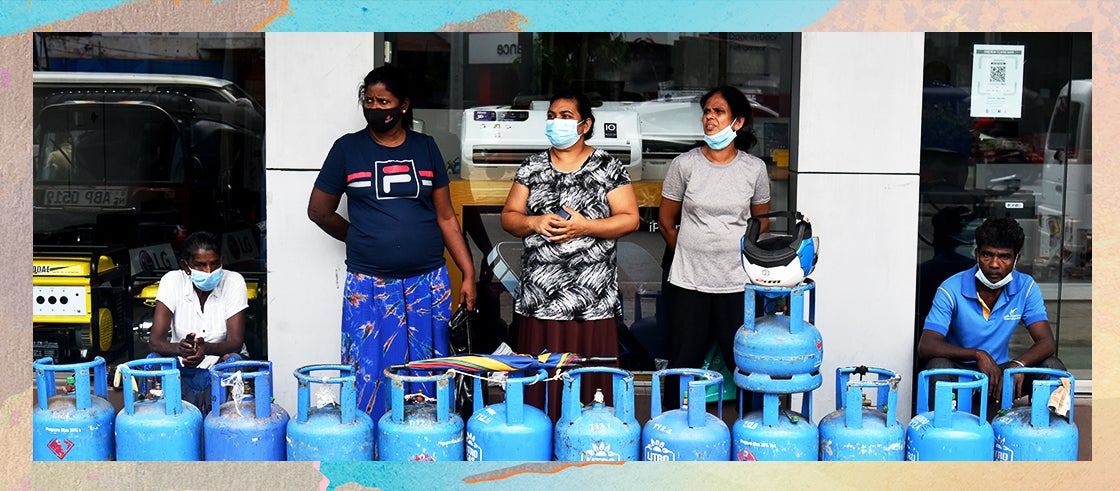 Photo of people lining up to get liquified petroleum gas in Sri Lanka.
Photo of people lining up to get liquified petroleum gas in Sri Lanka.
South Asian countries face competing policy priorities as they continue to address the scars from the COVID-19 pandemic amid a series of shocks rocking the region: devastating floods in Pakistan, the ongoing war in Ukraine skyrocketing commodity prices, tightening monetary policies by advanced countries, and slowing down the global economy. Along with these shocks, countries are facing mounting balance of payment pressures, case in point being Sri Lanka facing its worst economic crisis since the country’s independence in 1948. South Asia faces the daunting task of mitigating adverse impacts of these historic events while also crafting carefully calibrated policies to combat inflation and manage fiscal pressures. Here, we discuss some of the competing policy priorities the region faces, against the backdrop of expert opinions from the bi-annual survey of the South Asia Economic Policy Network (SAEPN), a group of policymakers, academics, and macroeconomists from across South Asia.
Continued recovery, a grim outlook
The latest South Asia Economic Focus (SAEF) titled Coping with Shocks: Migration and the Road to Resilience, reports that the region is expected to grow at 5.8 percent—a full percentage point lower than the forecast in June 2022. SAEPN experts too cast a less optimistic outlook than previous surveys while confirming continued recovery across South Asian economies:
- Fifty-six percent of respondents believe the level of economic activities is very close to pre-pandemic levels, compared to 44 percent in Spring 2022 and 36 percent in Fall 2021.
- Forty-eight percent believe the GDP growth will increase in the next six months, a drop from 56 percent one year ago.
- Thirty-seven percent believe high inflation is a major risk to economic recovery, similar to six months ago.
- Only 4 percent consider another COVID wave a major risk to the economy, a substantial and continued decline from 11 percent six months ago and 38 percent a year ago.
- Thirteen percent believe the widening current account deficit faced by countries is the biggest risk to the economy, similar to six months ago.
Taming the beast of inflation
With rising global food and energy prices, domestic inflation has spread from energy-related products to a broad range of food items and non-food, non-energy related products. Rising prices not only reduce real income for many households, but also increase the government’s fiscal burden, as the costs of fuel, food, and fertilizer subsidies rise.
To curb inflation, South Asian countries have tightened monetary policy at the expense of higher borrowing costs which could limit economic activities. However, only 37 percent of survey respondents agree that the central bank’s rate hikes are effective in curbing inflation, whereas another 37 percent disagree. This view is consistent with the analysis in Coping with Shocks, which finds that the impact of interest rate changes on inflation is weak in South Asia.
Although monetary policy tightening can lead to higher borrowing costs, innovations in digital financial services can help by predicting the borrower’s ability or willingness to repay and by offering other diverse tools to protect lenders in the event of default. SAEPN experts also agree:
- Eighty-one percent of SAEPN respondents agree that digital financial services and banking sector reform could help reduce borrowing costs for the private sector.
The SAEF analysis also suggests that the adoption of financial technology in banking sectors can sustain credits by changing the risk-taking behavior of banks.
Managing external sector pressures
Rising import bills due to elevated global commodity prices and recovering domestic demand; reduced momentum for export growth; stagnating remittance inflows through official channels; and net capital outflows due to monetary tightening by advanced economies and rising global uncertainties—all contributed to the dwindling foreign reserve and balance of payments tension in South Asia, as we find in Coping with Shocks. As a result of the external sector pressures, all major currencies in South Asia have depreciated against the dollar and trading partner currencies.
Stabilizing capital flows and exchange rates require countries to make difficult choices. To reduce import bills, many South Asian countries implemented import controls.
However, these restrictive measures to reduce external sector pressures can hurt economic recovery:
- Studies suggest that import bans can have a negative impact on export performance.
- Forty-eight percent of SAEPN survey respondents view these policies as ineffective, against 32 percent who see them as effective.
Rigid exchange rate regimes and efforts to stabilize exchange rate can also backfire:
- The analysis in SAEF contends that as exchange rate management artificially props up the local currency, parallel exchange rates can emerge, as did in Sri Lanka and in Bangladesh.
- Sixty-eight percent believe that incentives to attract workers’ remittances are an effective measure to draw foreign currencies, but parallel exchange rates can make them ineffective.
Ad hoc policies including quantity controls can distort price signals and have a negative impact on growth. Instead, countries may consider adopting more flexible exchange rate policies to allow for quantity adjustments. Accumulating enough foreign reserve buffer during normal times can also help countries deal with shocks. Policies that encourage migration will help boost remittances.
Ensuring food for all
Food insecurity is a major concern in South Asia. Five out of twelve Asian countries with the highest prevalence of insufficient food consumption are in South Asia. In response to the rising food prices, countries around the world including some South Asian countries that export food have implemented export restrictions.
However, export restrictions to ensure food security can feed into higher global prices:
- While these policies aim to secure domestic supplies of food and fertilizers, 40 percent of surveyed experts disagree with the move.
- The restrictions can feed into higher global prices and lead to further imported inflation for South Asian countries.
Instead, countries should strengthen global coordination to uphold a fair and market-oriented trading system in agriculture, so that poorer countries have access to affordable food and countries do not resort to ad hoc and restrictive trade policy measures that exacerbate food insecurity.
As we saw, South Asian countries are in a vulnerable position walking a policy balancing tightrope. To respond effectively to economic and natural shocks, they must spend on essentials like protecting the poor, yet be fiscally conservative; stop inflation but ensure that high interest rates don’t choke those dependent on credit; and ensure sufficient food supply for citizens, yet not stop exports. Now more than ever, balancing these contradictions is imperative to bolster resilience and establish economic prosperity across South Asia.
This is the first blog in a series based on the Fall 2022 bi-annual South Asia Economic Focus (SAEF) titled Coping with Shocks: Migration and the Road to Resilience, published by the South Asia Chief Economist’s Office at the World Bank.







Join the Conversation